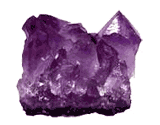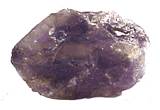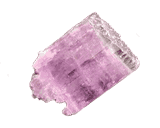| Gemstone Chart |
 Natural Amethyst Natural Amethyst
As a member of the quartz family, amethyst is one of the most common, hence under-appreciated, gemstones on the market.
Color: purple, violet
Categories: semi-precious stone
Chemical Composition: SiO2
Crystal Group: Hexagonal
Refractive Index: 1.544 - 1.553
Hardness: 7
Density: 2.66
Occurrence: Brazil, Uraguay, Bolivia, Madagascar, Russia, USA, Zambia
|  Natural Ametrine Natural Ametrine
Ametrine is a unique semi-precious gemstone that is a blend of citrine and amethyst.It has a warm, soft cream color that shows hints of both its lilac and honey hued parents.
Color: purple, violet, yellow
Categories: semi-precious stone
Chemical Composition: SiO2
Crystal Group: Hexagonal
Refractive Index: 1.544 - 1.553
Hardness: 7
Density: 2.66
Occurrence: Brazil, Bolivia
|  Natural Chalcedony Natural Chalcedony
Chalcedony is a catch all term that includes many well known varieties of cryptocrystalline quartz gemstones. They are found in all 50 States, in many colors and color combinations, and in sedimentary, igneous, and metamorphic rocks.
Color: grayish, purple, white, green, blue, lavender, yellow, brown
Categories: semi-precious stone
Chemical Composition: SiO2
Crystal Group: Hexagonal
Refractive Index: 1.530 - 1.539
Hardness: 6.5
Density: 2.57 ¨C 2.64
Occurrence: Brazil, U.S.A. Germany, India, Uruguay, Austarlia, Egypt, Italy, Scotland, South Africa, Namibia, Madagascar, Mexico, Tanzania, and many other localities throughout the world.
|  Natural Kunzite Natural Kunzite
Kunzite is the pink to light purple gem variety of the mineral Spodumene.Although kunzite is a relatively soft and delicate gem, and can fade after prolonged exposure to light, its appealing color makes it a popular gem. Small gems are seldom cut from kunzite because of its cleavage and strong pleochroism. It is rarely seen in rings, necklaces, or any other forms of jewelry where small stones are required.
Color: Pink, Lilac, Light Violet
Categories: semi-precious stone
Chemical Composition: LiAlSi2O6
Crystal Group: Monoclinic
Refractive Index: 1.660 - 1.675
Hardness: 7
Density: 3.17 - 3.19
Occurrence: Africa, Brazil, Canada, Madagascar, Mexico, Myanmar, Afghanistan, Sweden, and USA (California).
|  Natural Rhodolite Natural Rhodolite
Rhodolite is a beautiful pink to violetish red garnet which was named after the rhododendron flower. Commercially rhodolite is one of the most important garnets. Rhodolite is quite available in small sizes which are relatively low in price. Very fine large rhodolite garnets are rare and are moderate in price.
Color: red, purple-red
Categories: semi-precious stone
Chemical Composition: Al2(SiO4)3
Crystal Group: Cubic
Refractive Index: 1.75 - 1.77
Hardness: 7.25
Density: 3.74 - 3.94
Occurrence: Brazil, East Africa, Ceylon, India, Madagascar, Zimbabwe
|  Natural Tourmaline Natural Tourmaline
Tourmaline is actually a group of several different minerals which have similar crystal structures, but complex and variable chemical formulas. Tourmaline is the most varicolored of all gemstones. It occurs in all colors, but red, green, and multicolored are its most famous gem colors.
Color: blue, bluish green, green, greenish blue, green-blue or blue-green, greenish yellow, orangy red, red, red-orange or orange-red, red-purple or purple-red, slightly purplish red, slightly yellowish green, strongly purplish red, strongly yellowish green, very slightly bluish green, yellowish green, yellow-green or green-yellow, colorless, brown, pink
Categories: semi-precious stone
Chemical Composition: (NaCa)(LI,MgFe,Al)9B3Si6(O,OH)31
Crystal Group: Hexagonal
Refractive Index: 1.624(+.005, -.005) - 1.644(+.006, -.006)
Hardness: 7-7.5
Density: 3.06 (.05, +.15)
Occurrence: Brazil, East Africa, Nigeria, Madagascar, U.S.A.
|
|
